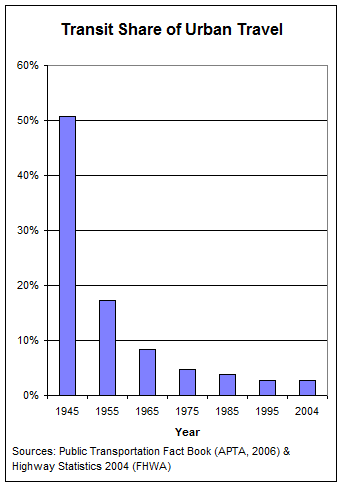Issue Brief
PUBLIC TRANSIT IS INCONVENIENT & UNCOMPETITIVE
Transit Is Not Rapid
We keep hearing that light rail transit is “rapid transit.” The trolleys, we are told, can reach speeds of 60 mph. Unfortunately, for transit advocates, the data on travel speeds does not make their case. According to the American Public Transit Association, the average speed of light rail transit is less than 16 miles per hour. But surely, this must still beat the “stop-and-go” pace of peak hour auto travel? Wrong again. Peak hour travel speeds for autos average 50 mph on the freeways and 30 mph on the city streets.
To view a copy of this table see this word document.
If we consider time costs of commuting by various modes, it quickly becomes clear why public transit’s share of the urban travel has been shrinking. Using a person’s annual income as an estimate of the value they place on their time, we find that as income level and an individual’s implicit value of time rises, public transit becomes a more expensive mode of travel.
The table above shows the combined cash and time costs of travel by car and transit for various income levels. Inasmuch as no amount of money that could be spent on transit systems in the future is likely to have a significant impact on transit travel times, it is clear that transit will never again serve anything other than a very small portion of the urban travel.
A Declining Industry
Public transit is a declining industry. Ridership peaked during the World War II period at 23 billion or so trips per year. World War II provided optimal conditions for transit ridership. Over 10 million young men were away from home, enlisted or drafted into the U.S. armed forces. Few of them owned or could use autos. Automobile manufacturing was discontinued. Gasoline was rationed—discouraging the use of autos by those persons who did own them. Under these conditions, public transit was able to capture 50% of the urban passenger miles of travel.
As World War II came to an end and life returned to a more normal peacetime mode, public transit lost most of its market advantages. Public transit’s share of urban passenger miles fell from 50% in 1945 to barely 3% by 2004.
Rising personal income increases the ability of families to own autos and houses. Residents without vehicles living in densely populated urban centers are likely customers for public transit. Auto-owning suburbanites are not. Public transit is what economists refer to as an “inferior” good. For a “normal” good, the quantity consumed rises as people’s income rises. For an “inferior” good, the quantity consumed falls as people’s income rises. As family incomes rose in the post World War II era, consumers shifted their demand from transit to automobiles as the preferred mode of travel. Once an auto is owned, the heavy fixed costs of ownership (depreciation, insurance, and financing) argue in favor of extending the use of the vehicle as much as possible.

Conclusion
Time is our most precious resource. We each have a very limited amount of it. Products and services that save time help conserve this most precious resource. Products and services, like public transit, that consume our time consume our most precious resource. Quite understandably, the overwhelming majority of consumers reject public transit for their own travel.
The demand that we must have a “balanced” transportation system rests on the expectation that running more buses and building a light rail line will get the other guy out of his car and out of our way. This is not rational. The other guy’s time is just as precious to him as our time is to us. Spending billions in taxes in the belief that the other guy will sacrifice his time for our convenience will be an exercise in futility.
This document was published by the Laissez Faire Institute, (480) 225-9832; e-mail jsemmens@cox.net. Permission to reprint this document, or any part thereof, is hereby granted. For more information see http://www.NoRailForScottsdale.com & http://www.goldwaterinstitute.org/Common/Files/Multimedia/399.pdf.